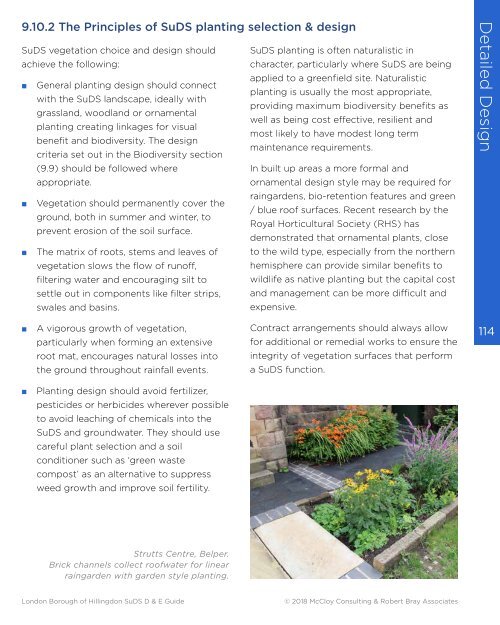Hillingdon SuDS Design & Evaluation Guide
You also want an ePaper? Increase the reach of your titles
YUMPU automatically turns print PDFs into web optimized ePapers that Google loves.
9.10.2 The Principles of <strong>SuDS</strong> planting selection & design<br />
<strong>SuDS</strong> vegetation choice and design should<br />
achieve the following:<br />
■■<br />
■■<br />
■■<br />
General planting design should connect<br />
with the <strong>SuDS</strong> landscape, ideally with<br />
grassland, woodland or ornamental<br />
planting creating linkages for visual<br />
benefit and biodiversity. The design<br />
criteria set out in the Biodiversity section<br />
(9.9) should be followed where<br />
appropriate.<br />
Vegetation should permanently cover the<br />
ground, both in summer and winter, to<br />
prevent erosion of the soil surface.<br />
The matrix of roots, stems and leaves of<br />
vegetation slows the flow of runoff,<br />
filtering water and encouraging silt to<br />
settle out in components like filter strips,<br />
swales and basins.<br />
<strong>SuDS</strong> planting is often naturalistic in<br />
character, particularly where <strong>SuDS</strong> are being<br />
applied to a greenfield site. Naturalistic<br />
planting is usually the most appropriate,<br />
providing maximum biodiversity benefits as<br />
well as being cost effective, resilient and<br />
most likely to have modest long term<br />
maintenance requirements.<br />
In built up areas a more formal and<br />
ornamental design style may be required for<br />
raingardens, bio-retention features and green<br />
/ blue roof surfaces. Recent research by the<br />
Royal Horticultural Society (RHS) has<br />
demonstrated that ornamental plants, close<br />
to the wild type, especially from the northern<br />
hemisphere can provide similar benefits to<br />
wildlife as native planting but the capital cost<br />
and management can be more difficult and<br />
expensive.<br />
Detailed <strong>Design</strong><br />
■■<br />
A vigorous growth of vegetation,<br />
particularly when forming an extensive<br />
Contract arrangements should always allow<br />
for additional or remedial works to ensure the<br />
114<br />
root mat, encourages natural losses into<br />
integrity of vegetation surfaces that perform<br />
the ground throughout rainfall events.<br />
a <strong>SuDS</strong> function.<br />
■■<br />
Planting design should avoid fertilizer,<br />
pesticides or herbicides wherever possible<br />
to avoid leaching of chemicals into the<br />
<strong>SuDS</strong> and groundwater. They should use<br />
careful plant selection and a soil<br />
conditioner such as ‘green waste<br />
compost’ as an alternative to suppress<br />
weed growth and improve soil fertility.<br />
Strutts Centre, Belper.<br />
Brick channels collect roofwater for linear<br />
raingarden with garden style planting.<br />
London Borough of <strong>Hillingdon</strong> <strong>SuDS</strong> D & E <strong>Guide</strong><br />
© 2018 McCloy Consulting & Robert Bray Associates


